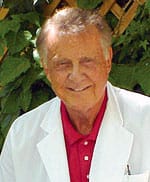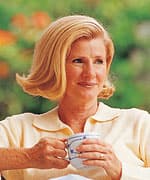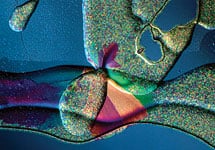Life Extension Magazine®
Gordon Reynolds, MD, has always felt a bit outside his own profession. Trained in obstetrics and gynecology at the University of Michigan and UCLA, he nevertheless had some novel and even controversial ideas of his own. Unlike most obstetrician gynecologists in the 1970s, Dr. Reynolds preached the power of nutrition and exercise to expectant mothers. He recommended folic acid to prevent birth defects and advocated nutritional supplementation. Even as mainstream obstetrics began to see the value of nutritional supplementation, however, it began to change in other ways that Dr. Reynolds found unacceptable. Starting in the late 1970s, technology began to make serious inroads into the practice of medicine. In many ways, this was a good thing, as improved diagnostics and imaging techniques allowed physicians to better understand what was happening inside the human body. However, a darker side to these developments, one sometimes overlooked by medical technologists, is that technology began to separate physicians from their patients. Coupled with the increase in lawsuits directed at doctors, Dr. Reynolds realized he was becoming unhappy in his profession of 30 years. “I felt that obstetrics had changed. When doctors were watching a monitor instead of having a hand on the abdomen, I knew it was time for a change,” he says. “In just a few years, the C-section rate at my hospital went from 3% to 18% because of using monitors, but there was no change in the delivery of healthy babies.” A Second CareerIn 1980, Dr. Reynolds decided to shift his focus. “What was happening in obstetrics bothered me to no end,” he says. “So rather than adapt, I got out of ob/gyn and went back to school at the University of Washington, UCLA, and Loma Linda.” His “second career” would help create the national spa movement, which served as a valuable incubator of ideas on general nutrition, holistic living, and longevity. Instead of pursing a PhD, he took courses across a broad range of disciplines that interested him, including nutrition and health. Gradually, his self-directed education and interest in longevity began to coalesce into a lifelong dedication to preventive medicine. Around this time, Dr. Reynolds joined the recently created Life Extension Foundation. From the beginning, Dr. Reynolds strongly believed in the Foundation’s goal of making health information widely available despite government obstruction. And he trusted Life Extension products to be purer and more current than those of other companies.
Only one step remained: Dr. Reynolds was still living in Redlands, CA, where his long-time patients naturally wanted to continue seeing him. He realized he was going to have to make a clean break, so he moved to Palm Springs, CA, in 1984. In those days, Palm Springs was the perfect environment for a physician interested in preventive medicine. A wealthy resort town full of spas and golf resorts, Palm Springs was known as a center of progressive medicine. Chelation therapy was being offered there, along with acupuncture and other forward-thinking solutions to the diseases of aging. In Palm Springs, Dr. Reynolds was considered a “mainstream” physician, and he went immediately into private practice. At the time, this meant recommending a diet of whole foods, high protein, no refined sugar or flour, lots of leafy green vegetables, and nutritional supplementation. As it turns out, Dr. Reynolds would not practice for long. In addition to golf and great weather, Palm Springs was known for its spas. Two years after relocating, he was approached by an investor who wanted to build a spa and wanted Dr. Reynolds to design a program of diet and exercise. Dr. Reynolds was interested, yet the project never got off the ground. However, when an opening arose for a physician supervisor at the world-famous La Costa Resort and Spa in Carlsbad, CA, Dr. Reynolds landed the job. Once he arrived at La Costa, he and his wife designed a program aimed at longevity and relief from the diseases of aging. Called the Life Fitness & Longevity Program, it was one of the first of its kind anywhere in the US.
“I felt we needed some place to practice preventive medicine and teach people how to get healthy,” he says. “Physicians were too busy to spend time with their patients and teach them anything. I thought we could use the spa as a center of learning.” The Life Fitness & Longevity Program was designed to help people with all sorts of health problems, from obesity and diabetes to hypertension. It was an intense, seven-day program of lectures, proper eating, and exercise. During the program, Dr. Reynolds and his wife submerged themselves in their patients’ well-being, doing the same exercises, going on the same hikes, and exchanging information. The program was so successful that it was soon copied in spas all over the country. “It was very, very successful,” Dr. Reynolds says. “Our follow-up information was very good. We even had people who were scheduled to have bypass surgery go on a special diet that reduced their cholesterol without drugs.” In the early 1990s, La Costa was sold to a Japanese business group that was more interested in developing the golf resort, and Dr. Reynolds soon announced his retirement. He eventually moved to St. George, UT, where he began lecturing on anti-aging medicine and longevity at the local Green Valley Spa. Still ahead of the curve after all these years, Dr. Reynolds lectures on several main topics, particularly cardiovascular disease, hormone therapy, and the dangers of refined carbohydrates. Understanding Heart DiseaseWhen Dr. Reynolds began studying nutrition, the medical community was just beginning to grapple with a national epidemic of heart disease. Today, heart disease is the leading killer of American men and women, and accounts for tens of billions of dollars of health-care expenditures every year. According to Dr. Reynolds, many misconceptions remain concerning the nature of heart disease, including an over-reliance on cholesterol and blood lipid levels to predict and treat heart disease. About half of all heart attacks occur in people with normal or low cholesterol levels, and some people with high cholesterol have no heart disease symptoms. “I realized there’s a hole in our knowledge,” says Reynolds. “There were so many people I was seeing who had no knowledge of heart disease being an inflammatory disease.”
Indeed, recent studies show that atherosclerosis often begins with mild inflammation in childhood and progresses gradually. As a building block of arterial plaque, cholesterol is only the surface issue. The underlying problem is inflammation of the arterial wall itself. This means that testing for levels of factors such as homocysteine, C-reactive protein, and fibrinogen may be far more predictive of heart attack risk than testing for cholesterol levels. Homocysteine, in particular, is directly linked to the presence of heart disease. While the correlation between C-reactive protein, an inflammatory blood marker, and heart disease is still a subject of some controversy, Dr. Reynolds believes it is better to be safe than sorry. “If you do a blood test and C-reactive protein is elevated, you can treat it with dietary measures, you’re not harming yourself, and you don’t need to take statin drugs, which I’m not a big fan of,” he says. “If we find out that C-reactive protein is a good measure in five years, we’ve helped a lot of people.” Even if C-reactive protein is not an accurate predictor of heart disease, there is little doubt that it is a sign of inflammation somewhere in the body. The measures Dr. Reynolds uses to treat it—vitamin C and omega-3 fatty acids—will attack inflammation no matter where it exists. Taking Hormones SeriouslyWhen controversy erupted over the widespread use of estrogen therapy in postmenopausal women, Dr. Reynolds says he was privately relieved, mainly because he feels this debate was long overdue. It is time, he believes, to have a national discussion about hormone therapy and the correct way to balance the various hormone systems. Ironically, Dr. Reynolds believes that many hormone problems are the direct result of our extended longevity. Studies have shown that sex and youth hormone levels peak at about age 35, depending on the hormone. By age 55, most sex hormones, including estrogen and testosterone, have declined significantly. Between the ages of 64 and 79, a severe lack of hormones contributes to many debilitating diseases. Dr. Reynolds asks, “If our first 50 years are our healthiest, and the next 50 years are spent in decline, shouldn’t we be looking at what gave us those healthy years?” This means carefully monitoring the five major hormones—estrogen, progesterone, testosterone, DHEA, and cortisol—and working with a qualified physician to maintain a youthful balance even into old age.
Refined to DeathWhile he spends most of his time focusing on positive things people can do, Dr. Reynolds reserves harsh criticism for the food industry and its efforts to market processed food products at any cost. “Sugar is an addictive taste, and the food companies know it,” he says. “Unfortunately, we begin reinforcing it as a reward for children, and now it’s stuffed into pretty much everything.” While refined sugar is the main culprit, he expands the definition to include other simple carbohydrates, like processed white flour and corn syrup. Moreover, even many “sugar-free” products contain sweeteners that he says are dangerous, including aspartame. His concern with these products is simple: by flooding our systems with simple sugar, we wreak havoc with insulin response and promote obesity. Much of that simple sugar is converted into fat, while wildly fluctuating insulin levels are associated with diabetes. Instead, Dr. Reynolds recommends a diet of whole grains and whole foods, saying, “A lot of people rarely come into contact with anything whole.” If sweetening is necessary, he recommends stevia, an herb that is many times sweeter than sugar, or xylitol, a sweetener with some crucial advantages. “We use xylitol almost exclusively,” he says. “It’s found in the body in small amounts and in nature. It doesn’t increase insulin levels, and some of its calories are never absorbed because it feeds the good bacteria in the colon. As he continues to lecture and learn more, Dr. Reynolds says the biggest frustration he often faces is from within his own profession. “Somebody once did a study that found it takes 17 years for a new idea to hit mainstream medicine,” he says. “But more and more physicians are becoming aware of things like the causes of heart disease and the importance of hormone balance. More discussion is taking place. And I know I’ll keep talking about it, because I’ve got nothing to lose.”
|





